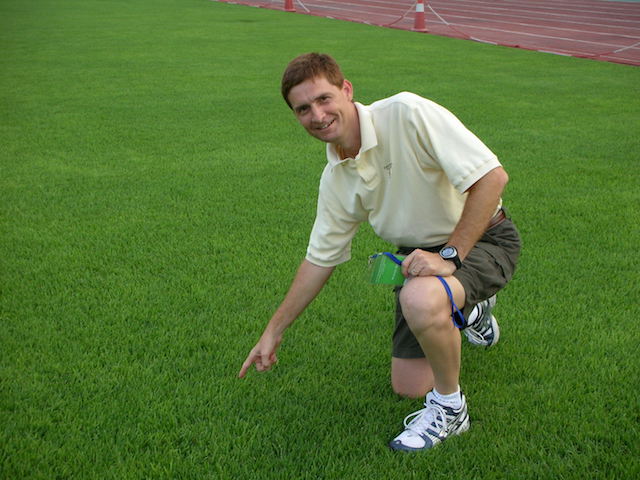Q: As I look over our badly worn bermudagrass fields that we used for high school soccer and football this spring, I wonder if I could have done something different that would have resulted in less bare ground. Any suggestions on managing for wear, and how it relates to a field’s capacity to handle the traffic?
A: Congratulations on making it through a tough spring. As you have experienced, even the best built and maintained fields have a limit to the amount of traffic the turfgrass can withstand without some damage – especially when used during a period of the year with limited turfgrass growth. In an ideal situation, an adequate number of fields would be available so use could be properly distributed and wear would not be a great concern.
Unfortunately, we do not always have ideal situations. Inadequate land for more fields, poor weather conditions during playing seasons, and concentrated use without recovery periods are all common reasons that some schools have looked to using synthetic field surfaces. There are still some things to do that can help preserve your natural grass surfaces from excessive wear.
Several facility-level management practices that can reduce wear and tear to natural turfgrass include:
1. Having separate play and practice facilities.
2. Preventing or minimizing play or practice when the soil is wet (saturated).
3. Rotating areas of play and practice to allow turfgrass recovery.
4. Avoiding concentrated foot traffic, such as band or cheerleading practices.
5. Allowing turfgrass recovery in spring from winter dormancy before using.
In some cases, these management practices may not be easy to accomplish due to scheduling. This spring, for example, many games and practices had to be played/held on dormant to semi-dormant bermudagrass. Overseeding the field surface with ryegrass could have helped with this issue. A good stand of ryegrass (seeded into a healthy bermudagrass base) provides a wearable surface that can offer some field protection for winter and spring play.
It is also important to adjust maintenance practices to address the conditions of the field. To prevent wear, use agronomic management practices that keep your turfgrass healthy and growing. But once the wear begins to show, step up the maintenance of those specific areas as much as possible. For example, apply supplemental nitrogen fertilizer to high-wear areas to promote recuperation; aerify high-wear areas with small solid tines during the season; and encourage coaches to move practices around the field as much as possible to avoid practicing in areas showing signs of wear.
I wish determining a field’s ability to handle wear at the beginning of a season was a simple process. Because field wear is influenced by so many variables, no definitive equation exists to predict when a field will begin showing signs of wear, or when a field will fail.
Years ago, I attempted to make educated predictions relating field use and turfgrass conditions for natural grass fields. These values were related to well-constructed fields that received at least moderate maintenance and were used under reasonable conditions during the year. The field use data suggested that a breaking point between very little wear and significant wear was somewhere between 800 and 1,000 hours of use per year.
This has been a good starting point, but I realize that substantial damage can be done to fields from one extremely wet game, while there are fields that receive 1,500 or more hours of use and still don’t have bare ground. As stated earlier, there are just so many variables that impact field wear.
What is important now is that you use good management practices to get your field back in shape. Address soil compaction through aggressive core aerification as soon as possible this summer, and make every effort to begin the next sporting season with 100 percent turf coverage.
Grady Miller, Ph.D.
Professor and Extension Turf Specialist
North Carolina State University
Questions?
Send them to Grady Miller at North Carolina State University, Box 7620, Raleigh, NC 27695-7620, or e-mail grady_miller@ncsu.edu
Or, send your question to Pamela Sherratt at 202 Kottman Hall, 2001 Coffey Road, Columbus, OH 43210 or sherratt.1@osu.edu

